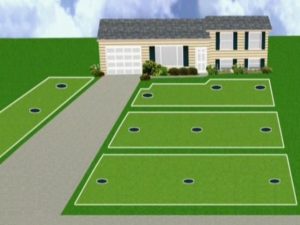 This is our second post about underground sprinkler installation and testing. Our earlier post covered setting up the manifold and the timer as well as laying out where the trenches will be dug. This post covers installation of the pipe, risers and sprinkler heads along with testing. Your trenches are already dug and it is time to install the pipes, risers and sprinkler heads.
This is our second post about underground sprinkler installation and testing. Our earlier post covered setting up the manifold and the timer as well as laying out where the trenches will be dug. This post covers installation of the pipe, risers and sprinkler heads along with testing. Your trenches are already dug and it is time to install the pipes, risers and sprinkler heads.
Install pipe, risers, and sprinkler heads. Lay out pipe and fittings on the ground, work backwards to the manifold, assemble and solvent weld pipe and fittings in the trench.
Measure the trench depth at each sprinkler head location, making the head flush with the soil surface. If you are installing sod, make the head 1 inch higher than the soil surface. Install risers, making further height adjustments as needed.
In areas where the soil freezes in winter, install drain valves at the lowest point in each circuit in between the control valves and the first gate valve near the water meter. Use a level to avoid having any water pockets in the system. Slightly tilt the drain valves down word in each circuit, cover them with a short piece of pipe, surround them with gravel then cover them with plastic film. Never put a drain valve in a fitting before attaching the fitting to the pipe; PVC solvent make log the valve.
After the pipe and risers have been installed, wait 12 hours for the solvent to dry. Then turn on the water to flush out any dirt, stones or scraps of PVC from pipe lines. When the pipes appear to be clear install the sprinkler heads.
Test for coverage.
Turn on each circuit one by one; inspect the sprinkler pattern carefully to make sure that every part of the ground is receiving adequate coverage. At this point, it is easy to add sprinkler heads if they are needed.
Backfill the trenches. Replace the soil in the trenches a little lower than the final soil line. Flood the trenches with water to settle the soil, then add more soil so that the back fill is mounded slightly. It will settle later.
This completes our second post regarding underground sprinkler installation and testing. Watch for more post about lawn mowing and taking care of your lawn. For other posts about sprinkler systems, click here.





